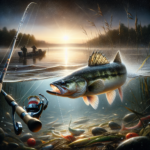Fishing Tips on How to Catch Largemouth Bass

Introduction
The largemouth bass (Micropterus salmoides) is one of the most sought-after fish species in North America, renowned for its aggressive behavior and thrilling fight when hooked. This freshwater fish is a favorite among sport and recreational anglers due to its widespread availability and the challenge it presents. In this article, we will delve into various aspects of largemouth bass fishing, including the best times to catch them, effective fishing techniques, recommended gear, prime locations, common mistakes to avoid, and ethical catch and release practices.
Fish Species Overview
Description
Largemouth bass are easily recognizable by their olive-green to greenish-gray coloration, with a series of dark blotches forming a jagged horizontal stripe along each flank. They have a large mouth that extends past their eyes, which is a distinguishing feature. Adult largemouth bass typically range from 12 to 15 inches in length and weigh between 1 to 5 pounds, although larger specimens can exceed 20 inches and weigh over 10 pounds.
Habitat
Largemouth bass thrive in freshwater environments such as lakes, ponds, rivers, and reservoirs. They prefer areas with abundant vegetation, submerged structures, and clear to slightly turbid water. Common regions where largemouth bass are found include the southeastern United States, the Great Lakes region, and various parts of Canada.
Behavior
Largemouth bass are opportunistic feeders, preying on a variety of organisms including smaller fish, crayfish, insects, and amphibians. They are most active during dawn and dusk, making these times ideal for fishing. Spawning typically occurs in the spring when water temperatures reach 60-75°F. During this period, males create nests in shallow waters and guard the eggs until they hatch.
Challenges
Anglers often face challenges such as locating largemouth bass in vast water bodies, dealing with their wariness in heavily fished areas, and adjusting to their changing behavior based on seasons and weather conditions.
Best Time to Catch Largemouth Bass
Seasonal Considerations
The optimal seasons for catching largemouth bass are spring and fall. During spring, bass are in shallow waters for spawning, making them easier to locate and catch. Fall is another productive season as bass feed aggressively to prepare for winter.
Time of Day
Largemouth bass are most active during the early morning and late evening hours. These periods offer lower light conditions, which make bass more comfortable and willing to venture out from cover to feed.
Weather Conditions
Ideal weather conditions for largemouth bass fishing include overcast days, which reduce light penetration and make bass more active. Calm waters are also preferable as they allow for better lure presentation and reduce the chances of spooking the fish.
Top Fishing Techniques for Largemouth Bass
Technique 1: Topwater Fishing
Topwater fishing involves using lures that float on the water’s surface, mimicking prey such as frogs or injured fish. This technique is effective because it triggers the bass’s predatory instincts, leading to explosive strikes. Popular topwater lures include poppers, frogs, and buzzbaits.
Technique 2: Jigging
Jigging involves using a weighted lure (jig) that is cast and then retrieved with an up-and-down motion. This technique is effective for targeting bass in deeper waters or around structures. Jigs can be tipped with soft plastic trailers to enhance their appeal.
Technique 3: Drop Shot Rig
The drop shot rig is a finesse technique that involves suspending a soft plastic bait above a weight. This setup allows the bait to hover just off the bottom, making it an enticing target for bass. It is particularly effective in clear water and during periods of high fishing pressure.
Pro Tips
- Use a slow and steady retrieve to mimic natural prey movements.
- Vary your lure presentation to find what triggers strikes on a given day.
- Pay attention to subtle bites and be ready to set the hook quickly.
Recommended Gear for Catching Largemouth Bass
Fishing Rod and Reel
A medium to medium-heavy spinning or baitcasting rod paired with a high-quality reel is ideal for largemouth bass fishing. Look for rods in the 6’6″ to 7’6″ range with fast action tips for better sensitivity and hook-setting power.
Fishing Line
Braided line with a fluorocarbon leader is a popular choice for its strength and low visibility. A line strength of 10-20 pounds is suitable for most bass fishing scenarios. For finesse techniques, consider using lighter lines in the 6-10 pound range.
Hooks and Baits
Use hooks in the 2/0 to 5/0 size range for most bass fishing applications. Popular baits include soft plastics (worms, craws, and swimbaits), crankbaits, spinnerbaits, and jigs. Natural baits such as live minnows or nightcrawlers can also be effective.
Additional Gear
- Bobbers: Useful for suspending baits at specific depths.
- Sinkers: Necessary for getting baits to the desired depth.
- Leaders: Fluorocarbon leaders help reduce line visibility and increase bite rates.
Best Locations to Find Largemouth Bass
General Locations
Largemouth bass are commonly found in lakes, ponds, rivers, and reservoirs. They prefer areas with ample cover such as submerged vegetation, fallen trees, and rock structures.
Specific Regions
Popular regions for largemouth bass fishing include the southeastern United States (Florida, Texas, Alabama), the Great Lakes region (Michigan, Wisconsin), and various parts of Canada (Ontario, Quebec). Notable fishing spots include Lake Okeechobee in Florida, Lake Fork in Texas, and the St. Lawrence River in New York.
Common Mistakes to Avoid
Mistake 1: Using the Wrong Gear
Using gear that is too heavy or too light can hinder your success. Ensure your rod, reel, and line are appropriately matched for largemouth bass fishing.
Mistake 2: Ignoring Seasonal Patterns
Failing to adjust your fishing strategy based on the season can lead to poor results. Understand the seasonal behavior of largemouth bass and adapt your techniques accordingly.
Mistake 3: Overlooking Subtle Bites
Largemouth bass can sometimes bite subtly, especially in pressured waters. Pay close attention to your line and be ready to set the hook at the slightest indication of a bite.
Catch and Release Tips
Importance of Conservation
Practicing catch and release helps maintain healthy fish populations and ensures future generations can enjoy the sport. Ethical fishing practices are crucial for conservation.
Proper Handling Techniques
- Use wet hands or a wet cloth to handle the fish to avoid removing its protective slime coat.
- Support the fish’s body and avoid holding it by the jaw alone.
- Minimize the time the fish is out of the water to reduce stress.
Legal Considerations
Be aware of local regulations regarding size limits, bag limits, and protected areas. Always follow these rules to ensure sustainable fishing practices.
Frequently Asked Questions (FAQs)
What is the best bait for catching largemouth bass?
The best bait for largemouth bass varies based on season and water conditions. Soft plastic worms, crankbaits, and spinnerbaits are popular choices. Live baits such as minnows and nightcrawlers can also be highly effective.
Where is the best place to fish for largemouth bass?
Largemouth bass are commonly found in lakes, ponds, rivers, and reservoirs with abundant cover. Popular fishing spots include Lake Okeechobee in Florida, Lake Fork in Texas, and the St. Lawrence River in New York.
What time of day is best for catching largemouth bass?
The best times to catch largemouth bass are early morning and late evening when they are most active. These periods offer lower light conditions, making bass more comfortable and willing to feed.
What type of fishing line should I use for largemouth bass?
Braided line with a fluorocarbon leader is recommended for its strength and low visibility. A line strength of 10-20 pounds is suitable for most bass fishing scenarios. For finesse techniques, consider using lighter lines in the 6-10 pound range.
Do I need a special fishing license to catch largemouth bass?
Yes, a fishing license is typically required to catch largemouth bass. Licensing requirements vary by location, so check local regulations for specific details on size limits, bag limits, and any special permits needed.
What is the best technique for catching largemouth bass?
Topwater fishing, jigging, and drop shot rigs are among the most effective techniques for catching largemouth bass. These methods trigger the bass’s predatory instincts and can be adapted to various conditions.
Are there any specific weather conditions that improve the chances of catching largemouth bass?
Overcast days and calm waters are ideal for largemouth bass fishing. These conditions reduce light penetration and make bass more active and willing to bite.
Can I catch largemouth bass from the shore, or do I need a boat?
Largemouth bass can be effectively caught from both shore and boat. Shore fishing is productive in areas with accessible cover, while a boat allows for greater mobility and access to deeper waters.
How can I improve my chances of landing a big largemouth bass?
To catch larger largemouth bass, use bigger baits, fish during peak feeding times (early morning and late evening), and target areas with ample cover. Patience and persistence are key to landing trophy-sized bass.
What should I do if I plan to release largemouth bass after catching them?
Practice ethical catch and release by handling the fish with wet hands, supporting its body, and minimizing the time it is out of the water. Follow local regulations and ensure the fish is healthy before releasing it back into the water.
Conclusion
Largemouth bass fishing offers an exciting and rewarding experience for anglers of all skill levels. By understanding the species’ behavior, using the right techniques and gear, and practicing ethical fishing practices, you can increase your chances of success. Whether you’re a seasoned angler or a beginner, the tips provided in this article will help you catch more largemouth bass and enjoy the thrill of the sport. So grab your gear, head to your favorite fishing spot, and put these tips into practice for a memorable fishing adventure.




